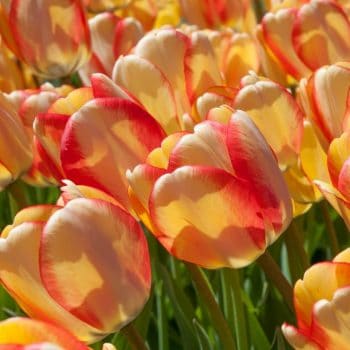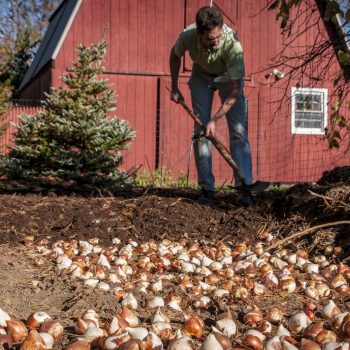If you live in a mild-winter climate, you’ve probably heard the term “prechilling bulbs.” What exactly does it mean, and do you really need to do it? Here’s everything you need to know to get your bulbs blooming their best.
What is meant by “prechilling bulbs”?
Most spring-flowering bulbs, including tulips and hyacinths, need a prolonged period of cold temperatures to grow and bloom properly. In much of the United States, this cold period is provided naturally by a winter spent in the ground. Bulbs planted in the Deep South, the desert Southwest, and most of California (more or less from the San Francisco Bay area south) do not get the cold they need. To perform well, they must be placed in a refrigerator (not a freezer) for 6 to 12 weeks before planting. For detailed instructions on how to prechill, read our article How to Prechill Spring-Flowering Bulbs.
Who should prechill?
In general, landscape professionals and gardeners in southern and western USDA Zones 7b–10 (excluding the Pacific Northwest and tidewater Virginia) should prechill bulbs before planting. The 7b line is not a hard one. Some gardeners in Zone 7b prechill; others don’t. A lot depends on how cold the upcoming winter is. Since it’s impossible to predict how severe a given winter will be, we recommend prechilling, just to be safe. (We advise gardeners in Zones 9–11 in the Southeast—along the Gulf Coast and in Central and South Florida—to avoid planting spring-flowering bulbs entirely, prechilled or not.)
Do all bulbs need prechilling in mild-winter climates?
We suggest that all bulbs be prechilled, except those listed below. Please note that not all of these bulbs are adapted to growing in Zones 8–11. See the individual items on this website for their USDA Zone ratings.
- Alliums
- Amaryllises
- Daffodils (Narcissus)
- Paperwhites
- Snowdrops (Galanthus)
- Snowflake (Leucojum)
- Spanish bluebells (Hyacinthoides)
How long do bulbs need to be prechilled?
Somewhere between 6 and 12 weeks—the longer the better. Bulbs that are to be planted in Southern California and in Zone 8b and warmer in the South need at least 10 weeks. In Dallas and Atlanta, we recommend 8 weeks. Bulbs destined for Northern California and the Upper South can generally perform well with just 6 weeks of chilling.
The prechilling mantra goes like this: More is better than less. You cannot over-chill bulbs. That said, spring-flowering bulbs must be planted in fall, early winter at the latest.
What will happen if I plant bulbs without prechilling them?
Bulbs that don’t get sufficient chilling tend to be stunted. They may bloom, but the flowers often open down in the leaves. In general, you will have a smaller, shorter plant and flower.
Does prechilling ensure a great display?
Most spring-flowering bulbs hail from climates where winter is severe and spring is long and cool. Prechilling tricks the bulbs into “thinking” they’ve had a cold winter but does not prepare them for an early March heatwave or a late wintry blast when the flowers are in their prime. To our southern and California customers we say: Prechill your bulbs, ensure they have the water they need from planting through bloom and keep your expectations modest. The quality of the display is in nature’s hands.
Please also be aware that prechilled bulbs may bloom taller or shorter than the heights specified on this website. Flowering times may also vary.
Can I prechill bulbs myself?
Sure, and for small orders, that’s what we recommend—to avoid the extra expense of having us do it and to adjust the prechilling schedule to suit your own. Use an extra fridge that is otherwise used to chill soft drinks or beer. Do not put bulbs in your main refrigerator; they are not food and have not been handled as food must be handled. Please be aware that bulbs should not be stored in a fridge that also contains fruits or vegetables, which can give off ethylene gas. Ethylene is harmless to people but can injure flowerbulbs.
When do I prechill and when do I plant?
We suggest you order your bulbs before the end of September for delivery around the middle of October. When the bulbs arrive, place them in the refrigerator for 6–12 weeks, according to your geographic location. Your bulbs will be ready to plant between late November and early January. We do not recommend planting after the middle of January.
Does Colorblends prechill bulbs?
Yes, but space in our cooler is limited. We offer our prechilling service only when the bulbs that require prechilling on an order exceed two crates, which is best visualized as the space occupied by 1200 tulip bulbs.
We charge a flat fee of $50 per order for prechilling. The fee covers handling and the cost of electricity.
If your order qualifies for prechilling and you would like us to prechill your bulbs, we ask that you do the following:
1) Place your order by mid September.
2) Select a delivery week when placing your order. For 6 weeks of chilling, we suggest delivery in late November or early December, for 8 weeks mid-December, for 10 weeks late December, for 12 weeks early January.
Please note: It is very difficult for us to ship a prechill order earlier than its scheduled week. We pack our cooler starting with the last orders to be shipped and finishing with the first due out. It is all but impossible for us to find an individual order once the cooler is packed. Please take care to choose a delivery week you can live with.
How do I request the Colorblends prechilling service?
If your order is to be delivered to an address in Zone 7b or warmer in the South or West and the bulbs that require prechilling on the order amount to the volume of about 1200 tulip bulbs, or two full crates, you will be given the prechill option during checkout. If you order by phone, you can discuss prechilling with any member of our staff. Order by fax or mail? Indicate that you want your bulbs prechilled, specify a delivery week, and add the $50 fee to your order.
Note: If you want Colorblends to prechill your bulbs, you must place your order by mid September.
Do prechilled bulbs require special handling at planting time?
No, but once you remove the bulbs from your refrigerator or they arrive on your doorstep, they must be planted right away. Also make sure to keep the bulbs out of direct sun while they’re awaiting planting. The chilling begins to wear off when bulbs are exposed to temperatures above 40 degrees F. So don’t delay, get prechilled bulbs into the ground quickly.
Will prechilled bulbs bloom again in later years?
In general, no. You should treat prechilled bulbs as annuals. When they’re finished blooming, pull them up and toss them on the compost pile. We’ve heard reports that some of the smaller bulbs (e.g., grape hyacinths and some of the wild tulips) are willing in some areas to come back in subsequent years, but you can’t count on a repeat performance.
Need more information?
If you aren’t sure whether you need to prechill bulbs or you have questions about the prechilling process, give us a call at (888) 847-8637. We’ll be glad to help.


